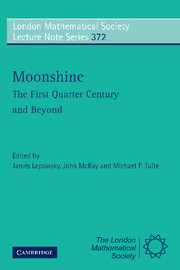 Moonshine - The First Quarter Century and Beyond
Moonshine - The First Quarter Century and Beyond Book contents
- Frontmatter
- Contents
- Preface
- Schedule of Talks
- Characters of Crossed Modules and Premodular Categories
- On the Injectivity of the Kudla-Millson Lift and Surjectivity of the Borcherds Lift
- Ordered Spanning Sets for Vertex Operator Algebras and their Modules
- Friendly Giant Meets Pointlike Instantons? On a New Conjecture by John McKay
- Modularity of Trace Functions in Orbifold Theory for ℤ-Graded Vertex Operator Superalgebras
- Twisted Modules for Vertex Operator Algebras
- Vertex Operators and Sporadic Groups
- The Algebraic Meaning of Being a Hauptmodul
- Borcherds' Proof of the Conway-Norton Conjecture
- On the Connection of Certain Lie Algebras with Vertex Algebras
- Vertex Operators and Arithmetic: How a Single Photon Illuminates Number Theory
- Rational Vertex Operator Algebras and their Orbifolds
- Quasi-finite Algebras Graded by Hamiltonian and Vertex Operator Algebras
- On Certain Automorphic Forms Associated to Rational Vertex Operator Algebras
- Moonshine and Group Cohomology
- Monstrous and Generalized Moonshine and Permutation Orbifolds
- New computations in the Monster
Monstrous and Generalized Moonshine and Permutation Orbifolds
Published online by Cambridge University Press: 06 July 2010
- Frontmatter
- Contents
- Preface
- Schedule of Talks
- Characters of Crossed Modules and Premodular Categories
- On the Injectivity of the Kudla-Millson Lift and Surjectivity of the Borcherds Lift
- Ordered Spanning Sets for Vertex Operator Algebras and their Modules
- Friendly Giant Meets Pointlike Instantons? On a New Conjecture by John McKay
- Modularity of Trace Functions in Orbifold Theory for ℤ-Graded Vertex Operator Superalgebras
- Twisted Modules for Vertex Operator Algebras
- Vertex Operators and Sporadic Groups
- The Algebraic Meaning of Being a Hauptmodul
- Borcherds' Proof of the Conway-Norton Conjecture
- On the Connection of Certain Lie Algebras with Vertex Algebras
- Vertex Operators and Arithmetic: How a Single Photon Illuminates Number Theory
- Rational Vertex Operator Algebras and their Orbifolds
- Quasi-finite Algebras Graded by Hamiltonian and Vertex Operator Algebras
- On Certain Automorphic Forms Associated to Rational Vertex Operator Algebras
- Moonshine and Group Cohomology
- Monstrous and Generalized Moonshine and Permutation Orbifolds
- New computations in the Monster
Summary
Abstract
We consider the application of permutation orbifold constructions towards a new possible understanding of the genus zero property in Monstrous and Generalized Moonshine. We describe a theory of twisted Hecke operators in this setting and conjecture on the form of Generalized Moonshine replication formulas.
Introduction
The Conway and Norton Monstrous Moonshine Conjectures [CN], the construction of the Moonshine Module [FLM] as an orbifold vertex operator algebra and the completion of the proof of Monstrous Moonshine by Borcherds [Bo2] provided much of the motivation for the development of Vertex Operator Algebras (VOAs) e.g. [Bo1], [FLM], [Ka], [MN]. Another highlight of VOA theory is Zhu's study of the modular properties of the partition function (and n-point functions) for generic classes of VOAs [Z]. Zhu's ideas were generalized to include orbifold VOAs [DLM] whose relevance to Monstrous Moonshine is emphasized in refs. [T1], [T2]. Norton's Generalized Moonshine Conjectures [N2] concerning centralizers of the Monster group has yet to be generally proven using either Borcherds' approach or orbifold partition function methods although some progress has recently been made in refs. [H] and [T3], [IT1], [IT2] respectively.
In this note, we sketch a possible new approach to these areas based on permutation orbifold VOA constructions [DMVV], [BDM]. In particular, we introduce a theory of twisted Hecke operators generalizing classical Hecke operators in number theory e.g. [Se]. We then discuss permutation orbifold constructions where the classical Hecke operators naturally appear and finite group and permutation orbifold constructions where the twisted Hecke operators appear.
- Type
- Chapter
- Information
- Moonshine - The First Quarter Century and BeyondProceedings of a Workshop on the Moonshine Conjectures and Vertex Algebras, pp. 378 - 392Publisher: Cambridge University PressPrint publication year: 2010
- 3
- Cited by
